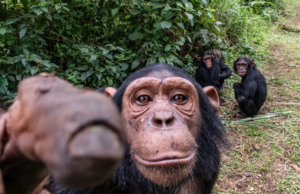Claustrophobia

We have 55 chimpanzees at GAP Great Apes Sanctuary of Sorocaba, in the countryside of São Paulo state. More than 15 individuals are originated from circuses. If we observe them, we will realize the difference between them due to the type of life they have undergone.
We have five chimpanzees who lived most of their lives, including their birth, in one of the most popular circuses of Brazil, the extinct Garcia Circus. These five have one thing in common: they are claustrophobic in the extreme. Quite different from others who came from different circuses.
There was a time Garcia Circus came to have 26 chimpanzees in its collection of animals. In two trailers, cages full of those chimpanzees travelled through Brazil and they lived for years with the unique opportunity to get out of their prison while they were very young, to act in the stage. Those chimpanzees are deeply claustrophobic.
Felipinho (Pinho) and Nega are older. Martin and Carioca (brothers) were born of a relationship from their parents through the bars separating them. Young Bruna also lived cloistered since her childhood and when we went to get her out of the cart, she did not manage to go out the door, and the grid had to be sawn.
When Felipinho arrived at the sanctuary he wanted to break all the doors; gradually he realized that the doors in the Sanctuary remained always open, except for a few minutes of cleaning work. Today Felipinho is another chimpanzee, gentle and caring with all the handlers and staff of the Sanctuary. Nega is a maximum case of claustrophobia, she never slept in an enclosed space, she rises to the top of the external house and sleeps there. No matter that it is cold or rain, she goes there with a blanket and there she spends the night and part of the day.
Martin is another who cannot resist the doors closed and still not worth trying to close him in a room, because he will try to break the door, no matter this hurts his arms and legs. Carioca, his brother, is another case of extreme claustrophobia. He always sleeps outside, get to eat inside the enclosure only if there is no one and if there is someone he trusts too much. He goes in and out fast, looking back and for both sides.
Bruna, who lives with Carioca, is another extreme case. She just enters the cafeteria, Quickly, she enters when there’s nobody in, takes her food and goes overseas. She never eats in a closed place.
Their enclosures are the ones that give the least work to the handlers, since the internal area, which is much used by other chimpanzees, and need daily cleaning, in this case they are hardly used and remains opened for a long time of the day.
All of them take the food, magazines, blankets etc. outside, so they do not have to run the risk of being imprisoned behind closed doors, which was the reality of their miserable lives when they were commercially exploited.
The claustrophobia (panic disorder) is one of the worst consequences detected in chimpanzees who underwent early life in a circus. Fortunately, today in Brazil and in most of the world, the existence of animals in circuses is a process of extinction, but those who lived there still support the ghost that haunts them daily, changing their normal way of enjoying life.
Dr. Pedro A. Ynterian
President, GAP Project International
Images of other chimps at Great Primates Sanctuary of Sorocaba – SP

 Español
Español
 Português
Português









